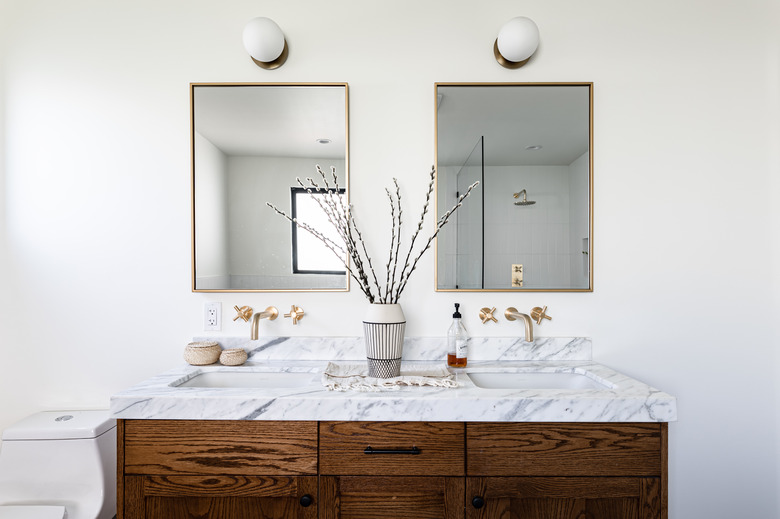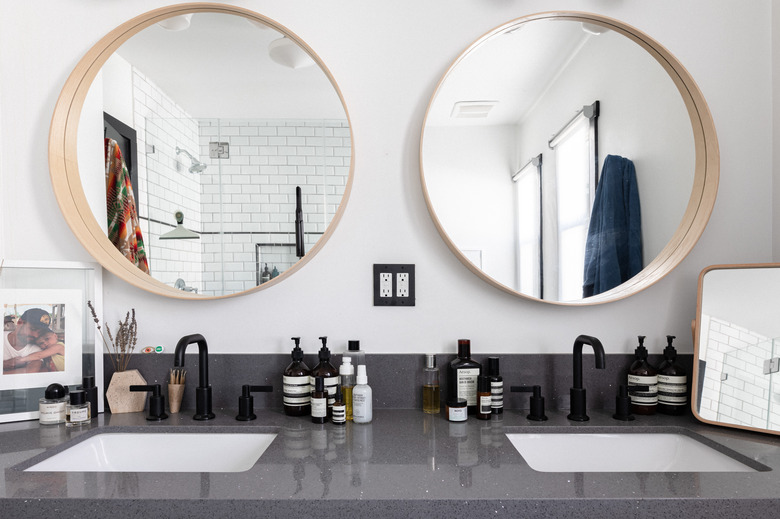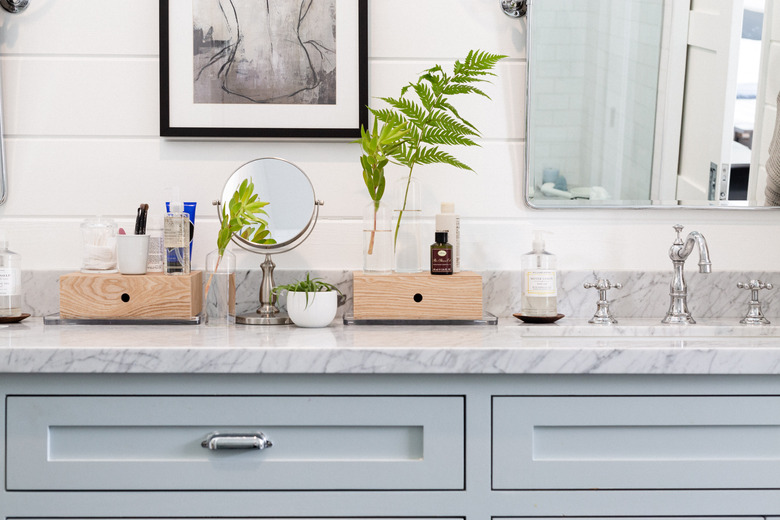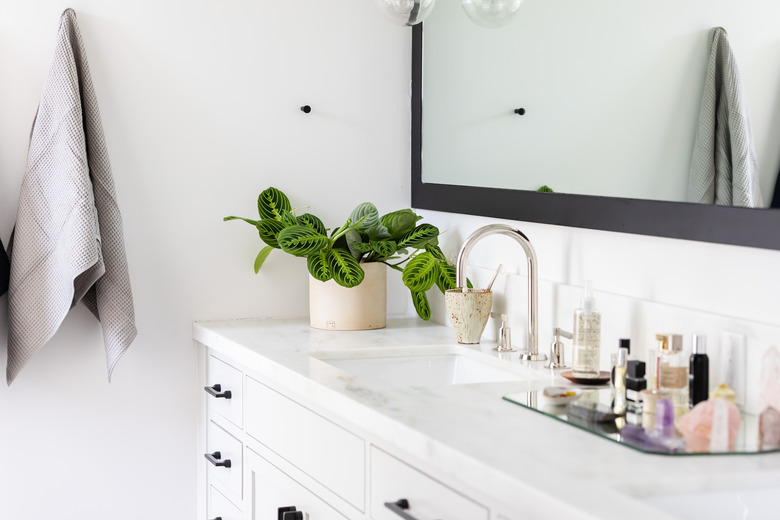Stone Vanity Countertops For Bathrooms: A Homeowner's Guide
We may receive a commission on purchases made from links.
The bathroom vanity you choose is going to be a part of your life for a long, long time. Even though you may know you want stone for your countertop, you may not know just how many different types of stone there are from which to choose. To pick the right material at the right price that has all the features you want, you need to know all your options and how they differ from each other.
Bathroom vanities can be purchased as whole units with countertops, sinks and faucets included and preassembled. Designs range from small pedestals with vessel sinks to larger, elaborate double-sink designs that include cabinets and drawers. Stone is a popular countertop choice because it's beautiful and has a natural look that fits in many bathroom designs. In small sizes, stone vanity countertops can be highly affordable.
Engineered Stone's Man-Made Beauty
Engineered Stone's Man-Made Beauty
Visually, it's difficult to tell the difference between natural stone and engineered stone. Aesthetically, an engineered stone bathroom vanity top is one of the best choices because it's available in a huge variety of colors. With this material, you can get just about any look you want. Engineered stone is made from crushed natural stone, usually quartz. Resins bind the pieces together.
Because of the way it's made, this stone is highly resistant to scratches and stains. Engineered stone has a hard, extremely durable surface that will stay beautiful for years. This material is even harder than granite and does not need to be sealed because of the resins used to bind the crushed stone together. However, engineered stone can be somewhat slippery to the touch because of those same resins.
Bath vanity tops made with engineered stone can even stand up to oils and acids because this material is so durable. A mild cleanser, warm water and a soft cloth are enough to keep an engineered stone bathroom vanity top clean and beautiful. Engineered stone is also heat-resistant.
Even though it's not a natural stone countertop, engineered stone is one of the most popular materials for bathrooms. Vanities with engineered stone counters are among the top sellers at Lowe's, ranging in price from about $200 to $2,000 for single-sink designs and around $500 to $3,000 for double-sink vanities.
Should You Choose Granite?
Should You Choose Granite?
Many people think of granite when they think of counters. It's a popular choice in kitchens, but many homeowners want it in the bathroom too. There are lots of reasons granite makes a good choice for a bathroom vanity. Granite is a hard, highly heat-resistant natural stone that occurs in a huge variety of colors. The material has beautiful striations and a distinctive look.
You need to use gentle cleaners and cloths to clean a granite vanity top. Don't use anything abrasive on granite because harsh chemicals and materials can scratch the surface and eat away at the stone. Remove stains with hydrogen peroxide and baking soda. Plain water and baking soda can be used to remove oil-based stains from granite.
Because granite is porous, it needs to be sealed regularly to maintain stain resistance. You'll want to seal this stone every one to three years. When water soaks into your granite countertop, it's time to seal the material. Water and liquids will bead up on your vanity top when the seal is working. When it's sealed, granite won't absorb most liquids, oils or other materials that may stain or discolor the stone.
A single bathroom vanity sink and granite top design ranges from around $250 to $3,000 at Home Depot. Double-sink designs cost $700 to $2,500 on average.
Make it Marble
Make it Marble
Since ancient times, marble has been a popular building and design choice. It's naturally beautiful and comes in a wide variety of color shades. The top-selling bathroom vanities at Home Depot are made with marble. This natural stone has a distinct look that's immediately recognizable. When you see marble, you know you're looking at marble. The natural striations are so distinct that "marbled" has become its own design aesthetic that appears in fabric patterns and even in sweets.
A marble countertop is easy to clean with mild dish soap and warm water. However, this material is sensitive to acids. You don't want to clean marble with lemon juice or vinegar, as this can damage the stone. Even sealed marble can be damaged and discolored by acids, according to Architectural Digest.
A marble top is stain-resistant and durable when it's sealed regularly, but it's not impervious to damage. Marble can be chipped and scratched. This stone may also crack when hot items are placed on it, but even if your marble is damaged, it can be sanded down and polished to restore the look. Many other bathroom vanity countertop materials — even other types of stone — cannot be repaired this way.
At Home Depot and similar retail stores, bathroom vanities with marble tops sell for anywhere from $400 to over $5,000 for large double bathroom vanity designs.
Why Try Soapstone?
Why Try Soapstone?
Soapstone has a beautiful look that adds character to any bathroom vanity. This natural stone is usually gray with white streaks. Because it's nonporous, unlike many other types of stone, this material doesn't need to be sealed to be stain-resistant. Soapstone is even glossier than marble, with a naturally shiny finish.
Over time, soapstone will develop a patina and become darker. You can hurry this process along by rubbing the material with mineral oil or linseed oil regularly. Eventually, soapstone will become black.
Unlike many other vanity tops in natural stone, soapstone has a high resistance to acids and other chemicals. It's also heat-resistant. Hot hair tools and mugs can be placed directly on soapstone without causing it to crack. Extreme heat can cause discoloration to soapstone, however.
Soapstone is softer than granite. This material can be damaged, chipped, scratched and cracked more easily than granite, marble and harder types of stone. Bathroom vanities with soapstone counters cost around $1,000 to $2,000 at Wayfair for single vanity sink designs and $2,300 to $2,700 for double vanity sink designs.
Nothing Looks Like Limestone
Nothing Looks Like Limestone
Nothing looks quite like limestone except limestone. This natural stone is made up of fossils and crystals that you can see. Limestone is only slightly less heat-resistant than granite and is more resistant to heat than marble.
However, as a bathroom vanity-top material, limestone can be rather high maintenance. This material has to be sealed with a sealant made especially for limestone. This task has to be performed regularly because limestone is naturally porous. When it isn't sealed, limestone is susceptible to staining and discoloration.
If your limestone does get stained, it can be treated with oxygen bleach, which doesn't chemically react with the stone. Acids of all kinds, including fruit acids, can cause etching and damage to a limestone countertop. For regular upkeep, you need a special pH-neutral cleaner and a soft cloth or soft-bristled brush to properly clean limestone.
A bathroom vanity with a limestone top will cost anywhere from $800 to over $1,500 for a single sink and $1,100 to $2,000 for double sinks at Wayfair.
What About a Travertine Top?
What About a Travertine Top?
Travertine is often seen in an Italian-inspired design theme. This pretty stone is durable enough to be used in flooring and is easy to clean with mild soap and plain water. The natural reddish and cream colors found in this natural stone create beautiful counter designs. A bathroom countertop made from this material has a look that immediately sets it apart from other options. Every piece of travertine is unique, which means you get a one-of-a-kind design with this material.
Because it's porous by nature, travertine has to be sealed regularly to be stain-resistant. Like many other stone choices, travertine can be damaged by fruit acids, vinegar and cleaners made with ammonia or bleach. Travertine is less stain-resistant and scratch-resistant than marble, granite and limestone.
A single-sink bathroom vanity with a travertine countertop at Lowe's ranges in price from about $640 to $2,100 on average. Double-sink designs cost $1,200 to $3,200.
Count on Quartz
Count on Quartz
Quartz is an extremely popular bathroom vanity-top option because it's available in a huge array of styles and colors. A quartz counter can look almost exactly like high-end marble or natural stone. Quartz is available in a truly dizzying number of variations and color options.
Quartz countertops were developed in Italy in the 1960s. They're made from ground quartz particles and resins pressed into a slab. Quartz counters were designed as an alternative to natural stone to be highly resilient and durable. This stone resists mildew, mold and heat damage up to 400 degrees Fahrenheit. This is why quartz can even be used in fireplace surrounds.
Quartz is more resistant to cracking, scratches and staining than most countertop options. On the Mohs scale of mineral hardness, most quartz counters rate at 7. Compare that to natural marble, which rates at 3. It can be hard to tell the visual difference between quartz and authentic marble, even on close inspection.
At Home Depot, vanities made with quartz counters in a single-sink design range in price from $400 to $3,500. Get a double sink for around $950 to $4,000.
The names are similar, but quartz and quartzite are two separate materials. Quartzite is engineered sandstone, and it is a type of mined, natural stone that has to be sealed regularly. Quartz, by comparison, doesn't need to be sealed.
References
- Attention Trust: Guide to Caring for your Natural Stone Counters
- Family Handyman: Countertop Options: The Pros and Cons of Countertop Materials
- The Home Depot: Bathroom Vanities with Tops
- Lowe's: Bathroom Vanities with Tops
- This Old House: All About Stone Countertops
- Wayfair: Stone Bathroom Vanities
- Ask the Builder: Limestone Countertops
- Consumer Reports: How to Clean Countertops and Keep Them Looking Their Best
- HGTV: Which Countertops Are Heat Resistant?
- Natural Stone Institute: R-Value for Natural Stone
- Architectural Digest: Marble Countertops: A Guide to Choosing & Maintaining White Marble



